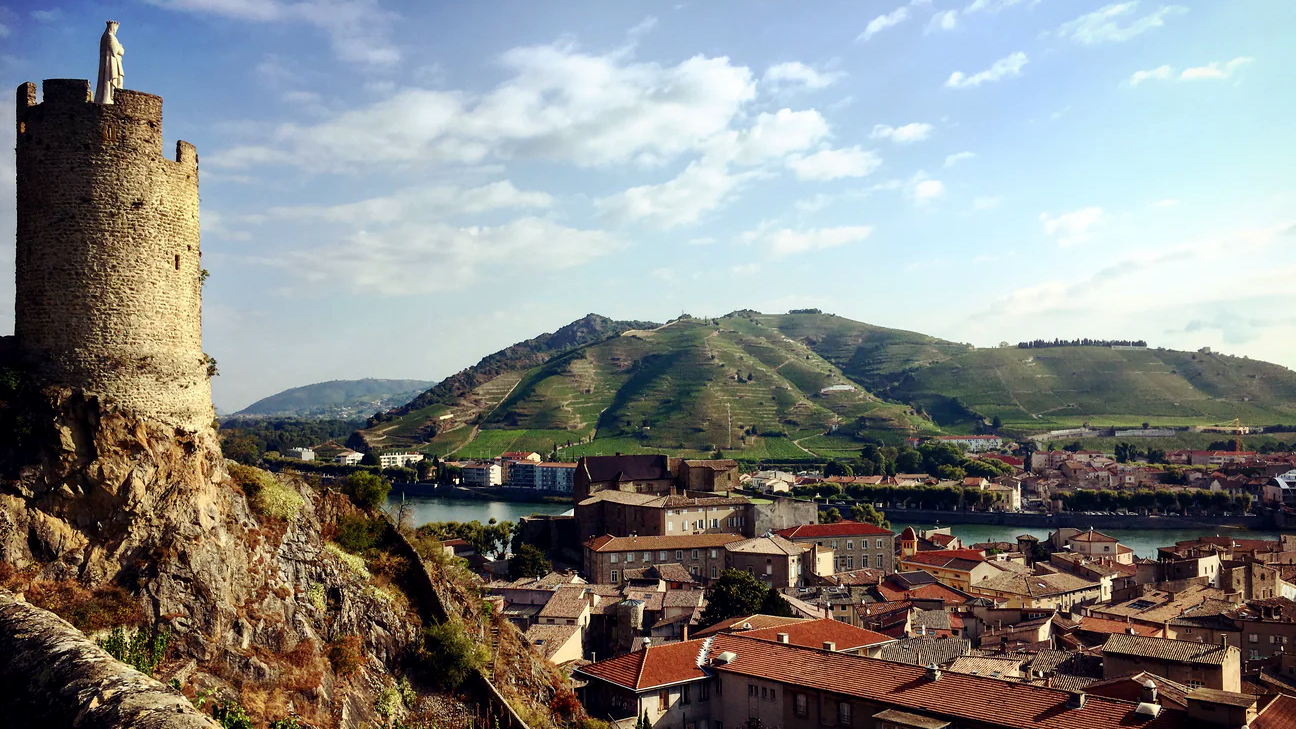Introduction to the Rhône Valley
The Rhône Valley is one of the most famous wine regions in France, stretching along the Rhône river. This region is famous for its high-quality wines, including the renowned Côtes du Rhône, Côte Rôtie and Châteauneuf du Pape. The southern Rhône in particular is known for its characterful red wines made from grape varieties such as Syrah, Grenache and Mourvèdre.
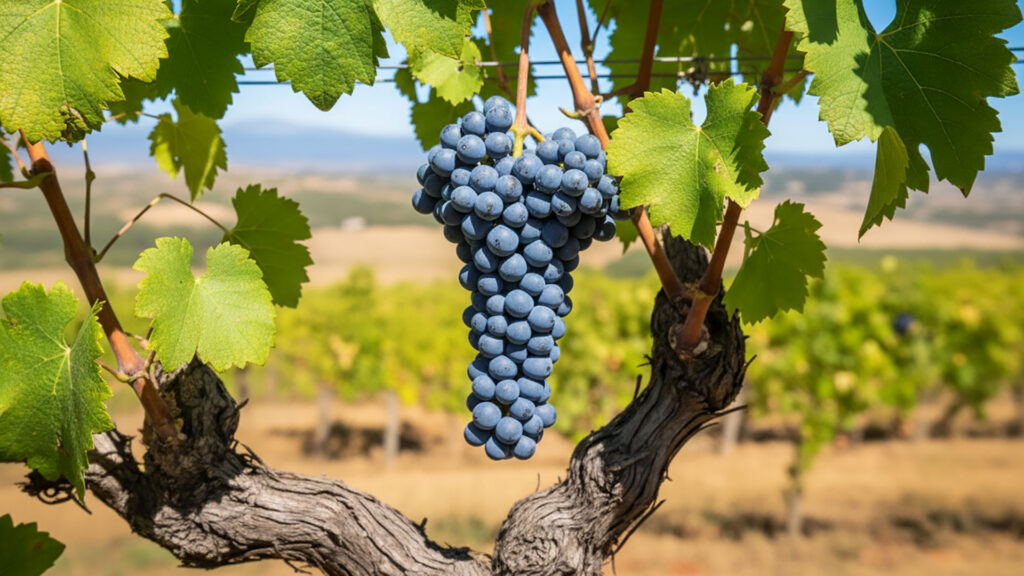
Wine production in the Rhône Valley has a long tradition dating back to the Middle Ages. Today, there are numerous wine estates and appellations in the region that are valued for their quality and diversity. The Côtes du Rhône Villages is one of the best-known appellations and stands for high-quality red wines made from Syrah, Grenache and Mourvèdre.
In addition to red wines, the Rhône Valley also offers an impressive variety of wines made from other grape varieties. White grape varieties such as Clairette, Roussanne and Bourboulenc contribute to the diversity of the wines, as do the rosé wines made from Grenache, Syrah and Cinsaut.
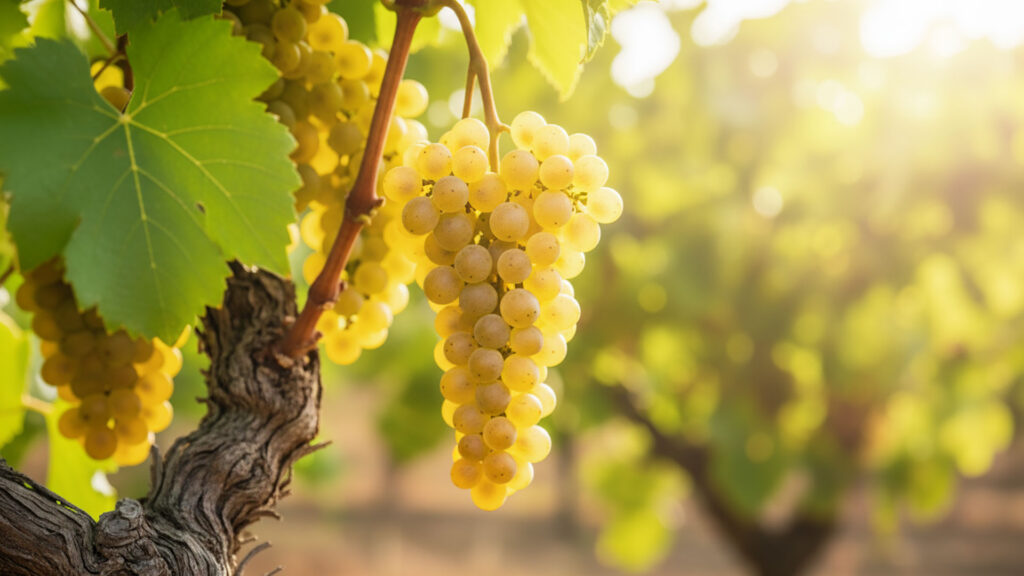
The Rhône Valley is a true paradise for wine lovers. The region offers a multitude of wineries that offer guided tours and tastings, as well as numerous wine events. A visit to the Rhône Valley is a great opportunity to learn about wine production and the rich history of the region.
In addition to its wines, the Rhône Valley is also known for its scenic beauty. The steep slopes, picturesque vineyards and charming villages make the region a popular tourist destination. Leisure activities such as hiking, cycling and boating on the Rhône river offer additional opportunities to enjoy the beauty of the region.
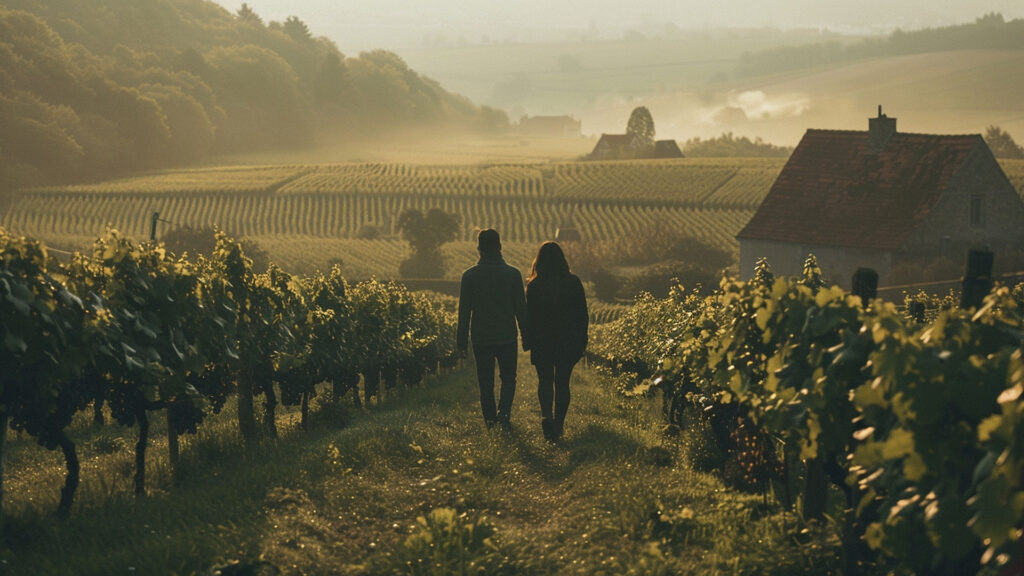
Overall, the Rhône Valley is one of the best-known and most popular wine regions in France. It is synonymous with high-quality wines, scenic beauty and a rich history. A visit to the Rhône Valley offers the opportunity to taste some of France’s best wines and experience the region’s culture first-hand.
The Rhône Valley as a historic wine-growing region
The French Rhône Valley is one of the oldest and most important wine-growing regions in Europe. It is an important wine-growing region that stretches along the Rhône river, from Lyon to Avignon, and impresses with its diversity of grape varieties, wine styles and appellations. French wine from the Rhône Valley enjoys an excellent reputation worldwide and stands for quality, craftsmanship and centuries-old tradition.
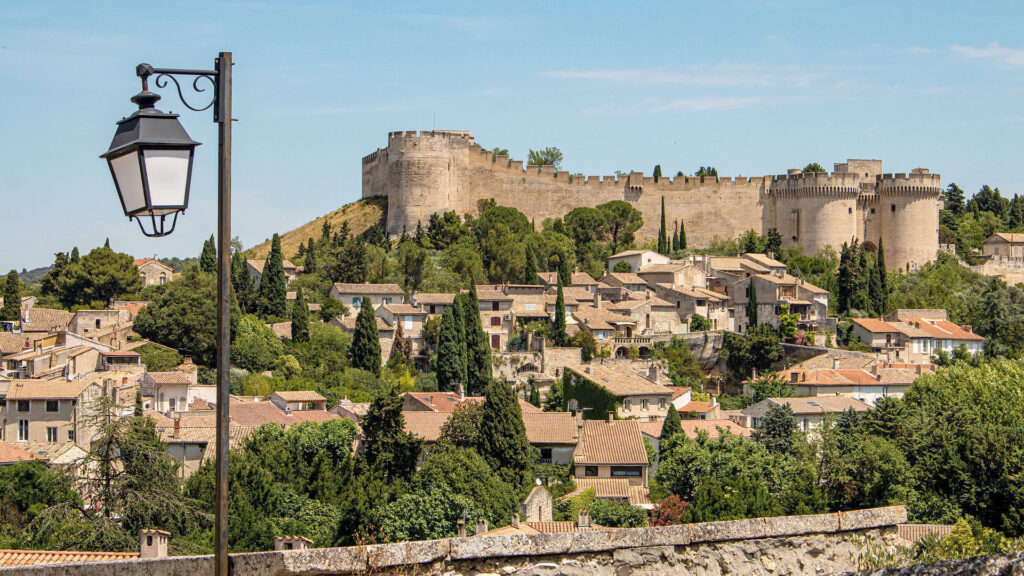
Even in ancient times, the Romans recognized the excellent climatic and geographical conditions of the Rhône Valley for viticulture. The favorable location between the Alps and the Mediterranean, coupled with different types of soil, enables the cultivation of a wide range of grape varieties. Today, the Rhône Valley wine-growing region delights with red wines, white wines, rosés and sparkling wines that impress with their aromas and diversity.
Geography and climate of the Rhône Valley
The Rhône valley is divided into two main areas: the northern Rhône and the southern Rhône. This division is not only important geographically, but also climatically and stylistically. While the north has a rather continental climate with cool winters and hot summers, the south is characterized by a Mediterranean climate with many hours of sunshine and the influence of the Mistral wind.
The soils of the Rhône Valley are diverse and range from granite and slate in the north to limestone, clay and pebble soils in the south. These geological differences are reflected in the character of the wines and contribute to the wide stylistic range of products from the Rhône Valley.
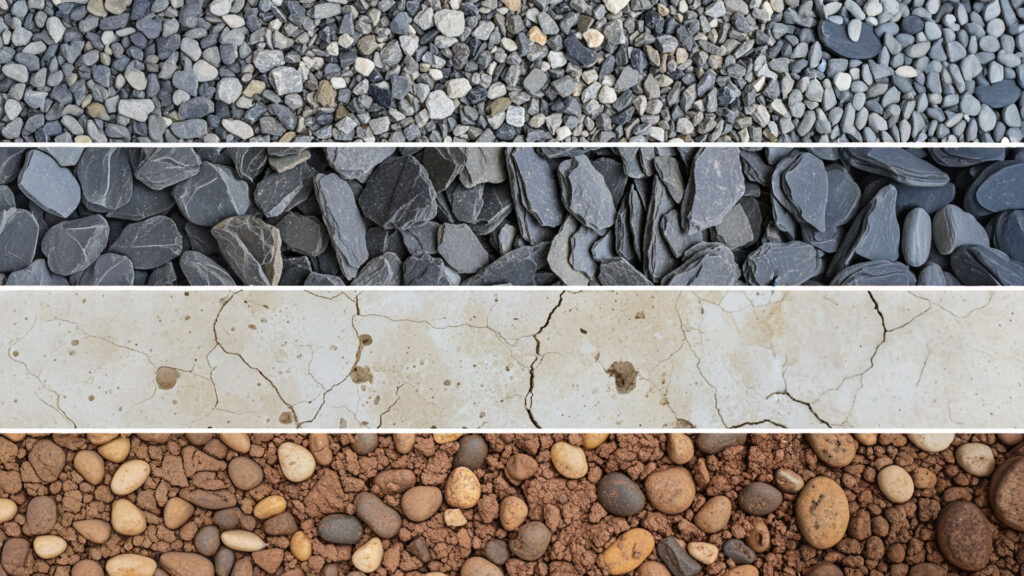
The most important growing regions of the Rhône
Within the Rhône Valley wine region, there are numerous appellations that differ in size, grape varieties and wine character. The best-known appellations are Côte Rôtie, Crozes Hermitage, Saint Joseph, Hermitage and Château Grillet in the north and Châteauneuf du Pape, Côtes du Rhône, AOC Côtes du Rhône, Côtes du Rhône Villages and Gigondas in the south. The wines under the designation ‘AOC Côtes du Rhône’ are characterized by their high quality and diversity and are an important part of the region’s winegrowing pyramid.
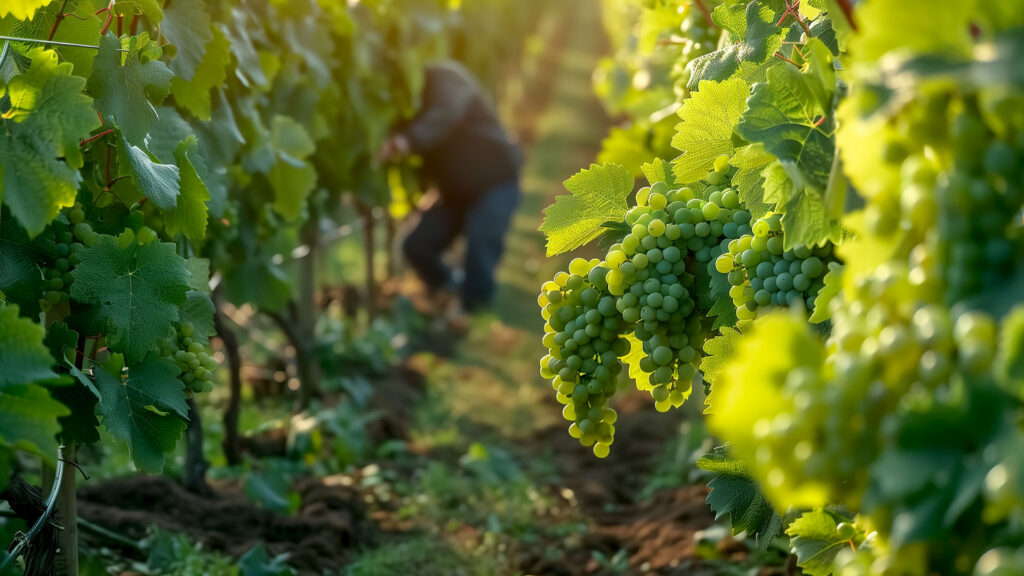
The northern Rhône valley is primarily known for its elegant and powerful red wines made from Syrah grapes. The southern Rhône, on the other hand, offers a greater variety of grape varieties, above all Grenache, supplemented by Syrah, Mourvèdre, Carignan and Cinsault.
Syrah, Grenache and other grape varieties from the Rhône Valley
The diversity of grape varieties in the Rhône Valley is one of the outstanding characteristics of this wine region. Syrah grapes dominate in the north and produce spicy, structured red wines with notes of black berries, pepper and violets. Grenache is the most important grape variety in the south and produces fruity, warm red wines with notes of cherries, raspberries and spices.
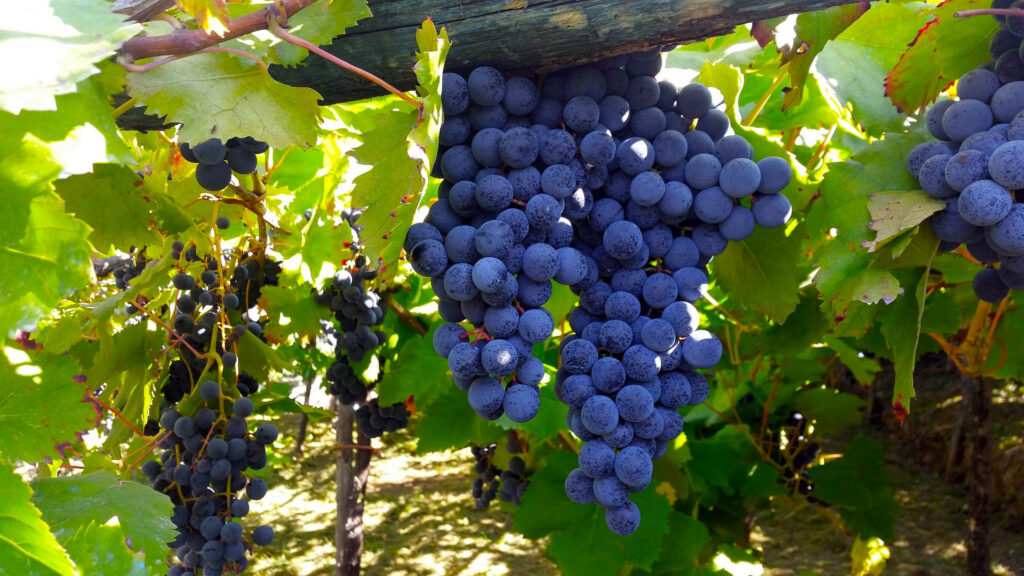
Other important grape varieties in the Rhône Valley are Carignan, Mourvèdre and Cinsault, which are mainly used in cuvées. Grape varieties such as Viognier, Marsanne, Roussanne and Clairette de Bellegarde play an important role in white wines. These varieties produce aromatic, floral and full-bodied white wines that offer great pleasure both young and matured. Grenache Blanc is also of great importance for the region’s white wines and contributes to the production of high-quality wines.
The role of the mistral wind for viticulture
The Mistral, a strong north wind that regularly blows through the Rhône valley, is a defining climatic element of the region. This wind has an important influence on viticulture, as it ventilates the vineyards well, reduces humidity and thus lowers the risk of fungal diseases. In the southern Rhône in particular, the mistral ensures that the grapes can ripen healthily. At the same time, the mistral influences the yields of wine production by positively influencing the quantity and quality of the grapes, which has a positive effect on the quality of the wines.
The drying effects of the Mistral produce concentrated, aromatic grapes, which in turn give the region’s wines their characteristic depth and expressiveness.
The influence of soils on wine styles
The geological conditions of the Rhône Valley have a decisive influence on the style of the wines produced there. In the north, granite and slate soils dominate, which store heat particularly well and therefore support the ripening process of the Syrah grapes. These soils give the wines a distinctive minerality and elegance. The vineyards in the Rhône Valley cover more than 60,000 hectares and offer ideal climatic conditions for viticulture.
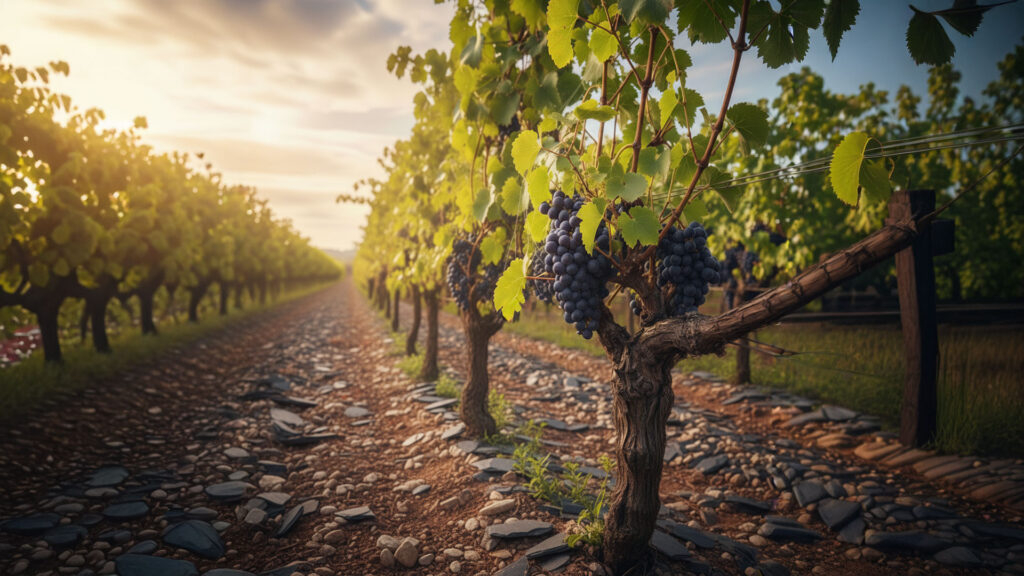
In the southern Rhône, on the other hand, there are often calcareous and clayey soils, often interspersed with pebbles, the so-called “galets roulés”. These store heat during the day and release it to the vines at night. The result is powerful, full-bodied wines with intense fruit and a balanced structure.
The most important appellations of the Rhône Valley
The Rhône Valley comprises numerous appellations that differ in terms of their geographical location, grape varieties and wine style. The Côte Rôtie appellation in the northern Rhône Valley stands for elegant, spicy red wines made from Syrah grapes, which are often refined with a small amount of Viognier. Various domains play an important role in this region, as their specific characteristics such as location, wine production and family tradition underline the uniqueness and importance of the vineyards. These wines are known for their complexity and ageing potential.
Further south, in Hermitage and Crozes Hermitage, powerful, full-bodied red wines are produced that impress with their balance between fruit, spice and structure. The Saint Joseph appellation is known above all for its fresh, mineral wines from Syrah and white wines from Marsanne and Roussanne.
Châteauneuf du Pape is one of the most renowned appellations in the south of the Rhône Valley. Up to 13 different grape varieties are used here, with Grenache playing the leading role. The wines from this appellation are characterized by their depth, power and complex aromas.
Also important are the Côtes du Rhône and the Côtes du Rhône Villages, which are known for their reliable quality and wide variety of wine styles. Red, white and rosé wines are produced here, reflecting the typical terroir of the Rhône Valley.
White wines from the Rhône Valley – aroma and freshness
Although the Rhône Valley is primarily famous for its red wines, white wines also play an important role. The region’s white wines impress with their freshness, floral aromas and balanced structure. Viognier, Marsanne, Roussanne and Clairette de Bellegarde are the dominant grape varieties for white wines in the Rhône Valley.
Viognier produces lush, aromatic wines that delight with notes of apricots, peaches and floral accents. Marsanne and Roussanne complement these aromas with fine herbal notes, structure and minerality. Clairette de Bellegarde provides freshness and a lively acidity that lends elegance and balance to the white wines.
These white wines are suitable both as an aperitif and as an accompaniment to a variety of dishes and show that the Rhône Valley has exciting discoveries in store not only for red wine lovers, but also for fans of aromatic white wines.
Rosé wines from the Rhône Valley – lightness and expression
In addition to the well-known red and white wines, the Rhône Valley also offers a selection of rosé wines, which play a particularly important role in the southern Rhône. These rosés impress with their delicate color, fresh fruit aromas and pleasant lightness.
Typical grape varieties for rosé production are Grenache, Syrah, Mourvèdre and Cinsault. The wines are characterized by aromas of strawberries, raspberries and a hint of citrus fruit. Their freshness and structure make them ideal for summer enjoyment or as an accompaniment to light Mediterranean cuisine.
Rosé wines from the Rhône Valley are very diverse in terms of style. From fresh, uncomplicated wines to more complex, structured rosés, they offer a wide selection for different occasions and tastes.
The red wines from the Rhône Valley – character and diversity
The red wines from the French Rhône Valley are the flagship of this traditional wine region and enjoy a high reputation worldwide. They stand for depth, spice and expressiveness and demonstrate the full range of climatic and geological conditions that the Rhône Valley has to offer.
Syrah is the dominant grape variety for red wines in the northern Rhône Valley. The Syrahs produced there are of high quality and are characterized by their exceptional finesse and structure. These wines are characterized by intense aromas of blackcurrants, blackberries, violets, pepper and sometimes smoky notes. The red wines from appellations such as Côte Rôtie, Hermitage, Crozes Hermitage and Saint Joseph are known for their finesse, structure and great ageing potential.
In the southern Rhône Valley, Grenache-based cuvées dominate, which are often combined with Syrah, Mourvèdre, Carignan and Cinsault. These red wines show warm fruit aromas of cherry, strawberry and plum as well as spicy notes such as thyme, rosemary and licorice. They usually have a softer tannin structure than their northern counterparts, but still have plenty of depth and volume.
A typical characteristic of red wines from the southern Rhône is their diversity: the spectrum ranges from fruity, uncomplicated wines from the Côtes du Rhône appellation to complex, powerful cuvées from Châteauneuf du Pape. The Côtes du Rhône Villages and neighboring appellations such as Gigondas, Vacqueyras and Cairanne also offer high-quality red wines that reflect the terroir of the southern Rhône in different ways.
The Rhône Valley is therefore one of the most diverse wine regions in France for red wine lovers. The combination of grape variety diversity, climatic influence, soil structure and traditional viticulture makes it possible to produce red wines with their very own character and great recognition value.
These wines are an excellent accompaniment to strong meat dishes, game and mature cheeses and are convincing both young and mature thanks to their expressiveness and elegance.
The role of cuvées in the Rhône Valley
A central feature of many wines from the Rhône Valley is the art of the cuvée. Different grape varieties are blended together to create balanced, harmonious and complex wines. Hot summers and mild winters are the rule in the region, which contributes to the regularity of quality and the typical characteristics of the wines. This practice is particularly widespread in the southern Rhône and shapes the character of the regional wines.
Grenache brings fruit and warmth to the cuvée, Syrah provides structure and spice, while Mourvèdre adds depth, color and storage potential. These are often complemented by Carignan or Cinsault, which add further nuances.
The careful selection and matching of grape varieties within a cuvée allows winemakers to minimize the influence of vintage differences and at the same time bring out the best characteristics of the individual varieties.
Tradition and modernity in Rhône Valley viticulture
Viticulture in the Rhône Valley has always combined tradition and innovation. While many wineries rely on centuries-old knowledge and traditional methods, they also use modern technology to further optimize the quality of their wines. Hand-picking, selective grape selection and gentle vinification are just as common as the use of modern cellar technology.
Environmental protection is also playing an increasingly important role. Many wineries in the Rhône Valley cultivate their vineyards organically or biodynamically, avoid the use of synthetic pesticides and promote biodiversity. The aim is to maintain healthy vines in a stable ecosystem and thus produce sustainable, high-quality wines.
This combination of tradition and modernity makes the wines from the Rhône Valley not only authentic, but also sustainable and innovative.
Wine and food – delicious combinations with wines from the Rhône Valley
The wines from the Rhône Valley are versatile accompaniments to a wide variety of dishes. Their aromas, structure and diversity make them ideal partners for delicious combinations with meat, fish, vegetables and cheese.
Red wines and hearty meat dishes
The powerful and structured red wines of the Rhône Valley, especially those made from Syrah grapes, harmonize perfectly with hearty meat dishes. These wines often contain a high proportion of the Syrah variety, while other varieties such as Marsanne and Roussanne can also be integrated in varying percentages. A red wine from Côte Rôtie or Hermitage emphasizes the taste of braised leg of lamb, game ragout or fillet of beef with pepper sauce. The intense aromas and subtle spiciness of the wines perfectly complement the roasted flavors of the meat.
Dishes from Mediterranean cuisine, such as lamb with Provençal herbs, ratatouille or grilled vegetables, can also be perfectly combined with the wines of the southern Rhône. Here, Grenache-based cuvées bring fruitiness and warmth into play, rounding off the flavor of the dishes.
White wines and light dishes
The white wines from the Rhône Valley, such as Viognier, Marsanne or Roussanne, are ideal accompaniments to fine starters, fish dishes and white meat. Viognier, with its floral aromas and notes of apricot and peach, is an excellent accompaniment to poultry dishes with fruit sauces, scallops or pike-perch fillet on a bed of herbs.
A white wine made from Marsanne or Roussanne also perfectly complements creamy risottos or mushroom dishes. The combination of freshness, body and aroma of white wines brings balance and harmony to the meal.
Rosé wines and Mediterranean dishes
The light, fresh rosé wines from the Rhône Valley are versatile accompaniments to Mediterranean cuisine. They go well with salads with goat’s cheese, fried prawns, bruschetta or antipasti. Light grilled dishes or couscous with vegetables also harmonize perfectly with the fruity rosés.
Dessert wines and cheese
Even if the Rhône Valley is not primarily known for dessert wines, there are some white wines with residual sugar that go well with cheese or mild desserts. A mature Viognier with a fine honey note can be an excellent choice with cheese variations or fruit compotes.
The classic French cheese selection, such as goat’s cheese or matured Comté, can be combined with white and red wines from the Rhône Valley just as enjoyably. The acidity and fruit of the wines support the aroma of the cheese.
The importance of winegrowers and vineyards in the Rhône Valley
The winegrowers in the Rhône Valley contribute significantly to the quality and character of the wines with their experience and craftsmanship. Many businesses have been family-run for generations and have passed on the knowledge of winegrowing from one generation to the next. The wine regions such as Côtes du Rhône and Crozes-Hermitage extend over numerous municipalities, with some municipalities bearing special designations that are important for the quality of the wine.
Particularly in the traditional wine regions such as the northern Rhône, but also in the southern Rhône, the winegrowers work intensively by hand in the vineyards. Selective harvesting and careful vinification are decisive factors for the high quality of the wines.
The trend towards organic and biodynamic farming has also become firmly established in the Rhône Valley. More and more wineries are adopting environmentally friendly cultivation methods and dispensing with chemical additives. This philosophy is also reflected in the style of the wines, which often express the character of their origin very clearly and authentically.
Viticulture as an economic factor in the Rhône Valley
Viticulture is an important economic sector in the Rhône Valley. Thousands of jobs in the region are directly or indirectly linked to wine production – from cultivation and cellar management to trade and tourism.
Wine festivals, tastings and wine tourism play an important role in the regional economy. Visitors from all over the world travel to the Rhône Valley to discover the diversity of local wines, take part in wine tastings and experience the picturesque vineyards. The availability of wine tastings and visits to wineries is always transparent and up-to-date, allowing for secure and flexible bookings.
This strong anchoring of viticulture in the social and economic life of the region underlines the importance of the Rhône Valley as one of the most important wine-growing regions in France.
Shelf life and ageing potential of wines from the Rhône Valley
Many wines from the Rhône Valley are characterized by their remarkable ageing potential. The red wines made from Syrah grapes in the northern Rhône Valley in particular, but also high-quality cuvées made from Grenache, Syrah and Mourvèdre from the south, benefit from a longer ageing period.
With ageing, these wines develop complex aromas of leather, tobacco, truffles and dried fruit, while the tannins become softer and smoother. Some white wines made from Marsanne and Roussanne also age well and gain depth and complexity over the years.
For wine lovers, it is worth enjoying wines from the French Rhône Valley both young and for longer periods. This diversity of enjoyment is a key quality feature of products from the Rhône Valley and confirms the excellent reputation of the French wine region.
The diversity of wine styles in the Rhône Valley
The Rhône Valley wine region offers an enormous range of styles. From light, fresh rosé wines to aromatic white wines and full-bodied, storable red wines, there is a suitable wine for almost every taste and occasion. In addition to the well-known Côtes du Rhône, there are a number of other A.O.C. wines in the Rhône Valley that underline the diversity and quality of this region.
The red wines of the Côte Rôtie and Crozes Hermitage impress with their depth and structure, while the Côtes du Rhône Villages stand above all for accessible wines that are suitable for everyday drinking, but still wonderfully reflect the terroir of the southern Rhône. Châteauneuf du Pape stands for powerful, complex cuvées that impress with their diversity of grape varieties and ageing potential.
These different wine styles reflect the characteristics of the Rhône Valley – from the continental north to the Mediterranean south, from the granite soil to the typical galets roulés. They show how the climate, the soils and the grape varieties in the Rhône Valley work together to produce wines of the highest quality.
Viticulture in the Rhône Valley between tradition and innovation
The Rhône Valley combines historical roots and modern demands. It is an important wine-growing region in France, known for its ideal geographical and climatic conditions that favor viticulture. The region’s winegrowers know how to combine the traditional knowledge of their ancestors with contemporary techniques and knowledge. Respectful treatment of nature and the vines always remains at the heart of wine production.
The vines are planted on vineyards, some of which are very old, and are often harvested by hand. Careful work in the vineyard and in the cellar guarantees the quality of French wines from the Rhône Valley. At the same time, many wineries integrate new methods, such as temperature-controlled fermentation, to preserve the freshness and aroma of the wines.
The importance of the Côtes du Rhône and Côtes du Rhône Villages appellation
A large proportion of wine production in the Rhône Valley falls under the Côtes du Rhône appellation, which is known for its wide variety of red, white and rosé wines. These wines are characterized by their balanced price-performance ratio and express the typicality of the Rhône Valley well.
The Côtes du Rhône Villages appellation is another quality indicator within the region. Here, stricter regulations apply to yields, grape varieties and origin. Wines from this appellation often have a more intense aroma, more structure and good ageing potential.
Some villages are also allowed to bear the name of their village on the label, which further strengthens the regional identity. This underlines the high quality standards of the wines from these special parts of the Rhône Valley. The wines named Côtes du Rhône and Côtes du Rhône Villages emphasize the importance of tradition and identity, which are protected and promoted in the history of winegrowing in order to preserve the reputation and prestige of the wines.
Châteauneuf du Pape – Icon of the southern Rhône
The Châteauneuf du Pape appellation is one of the best-known and most renowned wine-growing regions in the Rhône Valley. The vineyards are located on calcareous and clayey soils covered with large pebbles. Some parts of the appellation are characterized by steep, mountainous soils, while other parts are flat and stony, which contributes to the diversity of the wines. These “galets roulés” store the heat of the day and release it to the vines at night, which has a positive effect on the ripening process of the grapes.
Châteauneuf du Pape is famous for its diversity of grape varieties. Up to 13 different grapes can be permitted for the production of these wines, with Grenache usually playing the leading role. Syrah, Mourvèdre and Cinsault complement the cuvées and provide complexity, structure and aromatic depth.
The red wines from Châteauneuf du Pape stand for strength, elegance and longevity. Their aromas range from dark berries and Mediterranean herbs to spicy and earthy notes. White wines are also produced here, which impress with floral aromas, freshness and a fine minerality.
Côte Rôtie – elegance from the north
In the north of the Rhône Valley lies the Côte Rôtie appellation, which is known for its elegant and complex red wines made from Syrah grapes. In this wine region, a small amount of Viognier is often added, which gives the wines additional finesse and floral notes.
The steep vineyards of the Côte Rôtie benefit from optimal sunshine, which allows the grapes to ripen evenly. This side of the Rhône is characterized by its unique climatic conditions and terraced cultivation, which further enhances the quality of the wines. The resulting red wines are characterized by aromas of dark berries, spices, violets and a fine smoky note. Their elegant structure and well-integrated tannins make them outstanding representatives of red wines from the French Rhône Valley.
These wines have considerable ageing potential and develop an impressive complexity with increasing age.
Crozes Hermitage and Hermitage – variety at a high level
Crozes Hermitage is the largest appellation in the northern Rhône valley and offers a wide range of red and white wines. The top appellations of the northern Rhône, such as Côte-Rôtie and Hermitage, are known for their world-class wines, which are grown on steep slopes. The red wines from Crozes Hermitage are characterized by Syrah grapes and show a beautiful balance between fruit, freshness and structure. They are usually a little more accessible than their big brothers from Hermitage, but still impress with their typicity and quality.
Hermitage, on the other hand, stands for powerful, long-lasting wines that are characterized by depth, complexity and elegance. The red wines from Hermitage are among the best Syrah-based wines in the world and benefit from the unique location of the vineyards on sunny terraces along the Rhône river.
White wines from Marsanne and Roussanne are also produced here, which are characterized by their creaminess, aromatic diversity and ageability. Over time, these wines develop complex aromas of honey, nuts and dried fruit.
FAQ on wines from the French Rhône Valley
Which grape varieties dominate the Rhône Valley?
In the northern Rhône Valley, the Syrah grape dominates the red wines, while Grenache takes center stage in the south. The red wines must have a high proportion of the Syrah variety, while other varieties such as Marsanne and Roussanne can also be integrated in varying percentages. These main grape varieties are complemented by Mourvèdre, Carignan and Cinsault. Viognier, Marsanne, Roussanne and Clairette de Bellegarde are important among the white wines.
What characterizes the taste of wines from the Rhône Valley?
The wines from the Rhône Valley impress with their variety of aromas and styles. The world of wine in various appellations, such as Cornas and Hermitage, is characterized by unique historical and geographical aspects. Red wines from the north are known for their spice, black berries and fine tannins. In the south, the wines are fruity, spicy and full-bodied. White wines score with floral notes, freshness and balanced structure.
How long can wines from the Rhône Valley be stored?
Many red wines from the Rhône Valley, particularly from appellations such as Côte Rôtie, Hermitage and Châteauneuf du Pape, have good to excellent ageing potential. The hot summers in the Rhône region contribute significantly to this storage potential, as they promote the ripening of the grapes and the concentration of aromas. Depending on the vintage and style, these wines can easily age for ten years or more. Some white wines from Marsanne and Roussanne also show an impressive ability to age.
Which dishes go best with wines from the Rhône Valley?
The red wines of the Rhône Valley harmonize well with braised meat, game dishes and Mediterranean cuisine. White wines are excellent with fish, white meat, creamy risottos and fine starters. Rosé wines from the south of the Rhône are ideal with light grilled dishes, salads and seafood.

